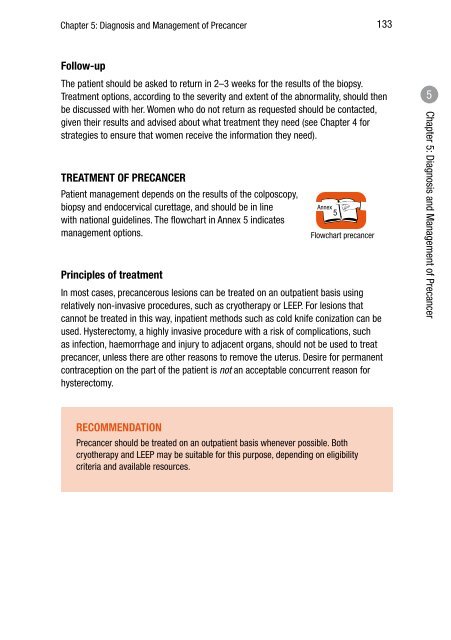CHAPTER 4: SCREENING FOR CERVICAL CANCER
CHAPTER 4: SCREENING FOR CERVICAL CANCER
CHAPTER 4: SCREENING FOR CERVICAL CANCER
Create successful ePaper yourself
Turn your PDF publications into a flip-book with our unique Google optimized e-Paper software.
Chapter 5: Diagnosis and Management of Precancer 133Follow-upThe patient should be asked to return in 2–3 weeks for the results of the biopsy.Treatment options, according to the severity and extent of the abnormality, should thenbe discussed with her. Women who do not return as requested should be contacted,given their results and advised about what treatment they need (see Chapter 4 forstrategies to ensure that women receive the information they need).TREATMENT OF PRE<strong>CANCER</strong>Patient management depends on the results of the colposcopy,biopsy and endocervical curettage, and should be in linewith national guidelines. The flowchart in Annex 5 indicatesmanagement options.Annex 5Flowchart precancerPrinciples of treatmentIn most cases, precancerous lesions can be treated on an outpatient basis usingrelatively non-invasive procedures, such as cryotherapy or LEEP. For lesions thatcannot be treated in this way, inpatient methods such as cold knife conization can beused. Hysterectomy, a highly invasive procedure with a risk of complications, suchas infection, haemorrhage and injury to adjacent organs, should not be used to treatprecancer, unless there are other reasons to remove the uterus. Desire for permanentcontraception on the part of the patient is not an acceptable concurrent reason forhysterectomy.5Chapter 5: Diagnosis and Management of PrecancerRECOMMENDATIONPrecancer should be treated on an outpatient basis whenever possible. Bothcryotherapy and LEEP may be suitable for this purpose, depending on eligibilitycriteria and available resources.
















